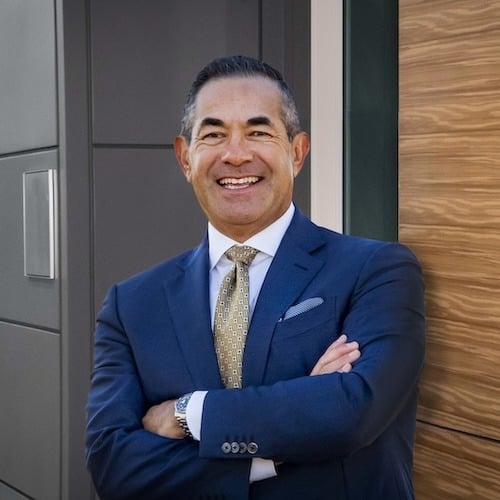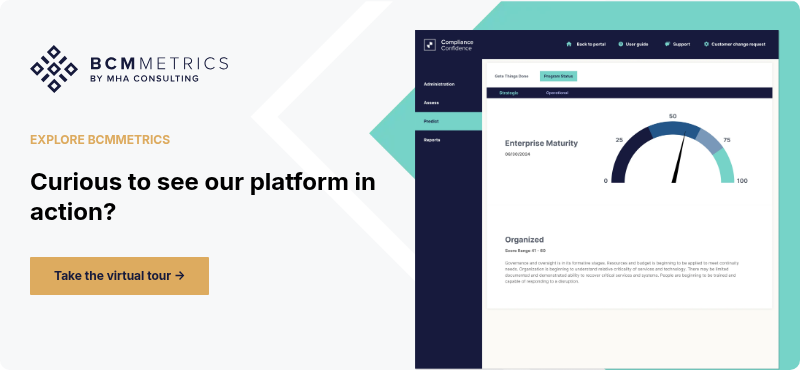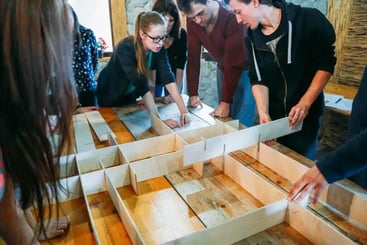Prepare For the Worst with the Best in the Business
Experience capable, consistent, and easy-to-use business continuity management software.
On paper, most crisis teams look strong — senior executives at the table, binders full of plans, meeting invites ready. But when real disruption hits, too many of those teams stall. Decisions drag, voices clash, and confidence collapses.
Teams built on hierarchy alone rarely perform under pressure. The ones that succeed share six traits that matter more than titles or thick binders.
Trait 1: A Leader Who Steadies the Room
After more than 25 years in business continuity, BCMMetrics’ founder and CEO Michael Herrera has seen the same failure again and again: poor leadership at the helm. Sometimes the most senior person dominates, talking over everyone until the call turns into a one-man show.
Other times, leaders delay decisions, waiting for consensus or perfect data before moving. In both cases, the clock runs down and the damage spreads.
The best leaders under pressure:
- Don’t chase 100 percent certainty. They act when they have enough information to move forward, then adjust.
- Set the tone by staying calm, which matters because a team often mirrors the leader’s temperament.
- Create space for others to contribute, even if the ideas sound unorthodox, because in a crisis the “crazy” suggestion can be the one that works.
Titles do not guarantee these skills. Herrera tells clients to look for people who can stay composed under stress, listen actively, and make timely calls with partial information. Those qualities—not seniority—decide whether the team drives the response or watches the clock.
Trait 2: A Team that Trusts Each Other Enough to Speak Up
Crisis teams falter when people hesitate to challenge senior voices or fear looking foolish.. When this happens, blind spots go unnoticed, and the group recycles the same ideas.
Strong teams work differently — they’ve built the trust to speak up, even when tensions rise. Members challenge each other, share unconventional points of view, and flag what others have missed. That trust comes from familiarity, practice, and knowing that disagreement will not be taken personally.
In practice, Trait 2 might look like a facilities manager raising an overlooked site risk, or a security analyst indicating a gap that others dismissed. In weak teams, those insights stay buried. In strong ones, they surface and get weighed quickly.
More than about harmony, collaboration under stress is about a team that knows each other well enough to argue productively and still keep the response moving.
Trait 3: Discipline in Making and Sticking to Decisions
The strongest teams decide with what they know, move forward, and adjust as new facts emerge. Discipline isn’t just the leader’s job — once a call is made, debate ends, and energy shifts to execution.
Without that shared commitment, a group can end up circling the same decision over and over, burning daylight and confidence. With it, even an imperfect plan gains traction because everyone is pulling in the same direction. That kind of discipline turns a shaky start into progress, and progress is what keeps the team from freezing when pressure is highest.
Trait 4: Situational Awareness Beyond the Immediate Fire
In a crisis, it’s natural to fixate on the fire in front of you. Servers are down. Phones won’t stop ringing. Everyone wants answers. But teams that only chase the immediate fire risk are setting themselves up for bigger problems later.
The best crisis teams keep one eye on the horizon. While part of the group works on containing today’s disruption, others are asking: what happens if this drags into next week? What will regulators or customers expect to hear tomorrow morning? What secondary impacts—supply chain, reputational, financial—are coming behind the first wave?
Michael Herrera warns that weak teams think in hours, while strong ones think in layers of time. Handling the immediate is necessary, but protecting the organization’s reputation and resilience means planning for the ripples too. Teams that balance both don’t just put out fires — they prevent flare-ups from becoming catastrophes.
Trait 5: Familiarity Built Before the Storm
You can't expect strangers to function like a seasoned unit when pressure hits. If members barely know each other or have not practiced together, the first real event becomes an awkward rehearsal at the worst possible time.
NASA has seen it in flight crews; you have seen it in boardrooms. When people train and test together—through exercises, drills, and yes, even surprise scenarios—they develop shortcuts and build trust.
They know who is detail-oriented, who is blunt enough to challenge, and who can bridge between groups under stress. That familiarity means less time wasted on introductions and second-guessing, and more time moving.
Trait 6: Adaptability When Plans Crumble
Every plan collides with reality: the crisis comes in sideways, key people are missing, or the sequence you rehearsed does not fit what is actually unfolding.
Michael Herrera stresses this point often: the best crisis teams know when to improvise. They do not cling to the script if it is steering them into a wall. They reshuffle roles, redirect resources, and cover gaps without letting pride or politics get in the way. In weaker teams, people freeze because “that wasn’t my responsibility.” In stronger ones, members step in, adjust, and keep the response moving.
Adaptability isn’t abandoning the plan—it’s using it as a backbone while flexing to meet the moment.
Traits Build Crisis Teams, BCMMetrics Helps Make Them Stick
Resilience depends less on documents—and more on the people in the room. Pressure has a way of revealing strength: carbon becomes diamond, and crisis teams let out their true character. Calm leadership, collaboration, timely decisions, situational awareness, trust, and adaptability make all the difference.
If you want those traits to show up consistently, you need more than instinct. BCMMetrics gives crisis teams one place to capture decisions, document actions, and adjust plans in real time—turning adaptability into a repeatable process you can rely on when everything else feels uncertain.
Ready to see how it works in practice? Take a virtual tour to explore how BCMMetrics can help your team perform when it matters most.
FAQ: Incident vs Crisis
Why can’t we just put our most senior executives on the crisis teams?
Senior executives don’t automatically make the best crisis team members. Michael Herrera has seen senior leaders freeze, dominate the room, or stall while waiting for perfect data. The traits that count—calm, decisiveness, trust-building, adaptability—don’t always come with rank.
How do we know if our crisis team actually has these traits?
A crisis team’s strengths only show up under testing. Running exercises that create real pressure reveals how the team responds. Do they listen? Do they decide quickly? Do they adapt when the script fails? The gaps show up fast when the environment isn’t staged.
What's the risk of keeping the wrong people on the team?
The risk of the wrong crisis team members is fatigue, confusion, and poor decisions. Teams dominated by the wrong personalities often recycle old solutions, overlook critical insights, and move too slowly. The cost shows up in longer downtime, higher financial impact, and reputational damage.
Can these traits be trained, or do we have to replace people?
Crisis team traits can be developed, though some—like staying calm under stress—are harder to build from scratch. Training, frequent exercises, and honest feedback give people the chance to improve. What matters is being honest about who fits and who doesn’t.
Where does BCMMetrics fit into building an effective crisis team?
BCMMetrics supports crisis teams by giving structure to critical traits. It helps crisis teams capture decisions, document actions, and adjust plans in real time. That recordkeeping turns adaptability into a repeatable process and helps prove to executives and auditors that your team isn’t just trained—it’s effective.

Michael Herrera
Michael Herrera is the Chief Executive Officer (CEO) of MHA. In his role, Michael provides global leadership to the entire set of industry practices and horizontal capabilities within MHA. Under his leadership, MHA has become a leading provider of Business Continuity and Disaster Recovery services to organizations on a global level. He is also the founder of BCMMETRICS, a leading cloud based tool designed to assess business continuity compliance and residual risk. Michael is a well-known and sought after speaker on Business Continuity issues at local and national contingency planner chapter meetings and conferences. Prior to founding MHA, he was a Regional VP for Bank of America, where he was responsible for Business Continuity across the southwest region.
.png)
.png)




